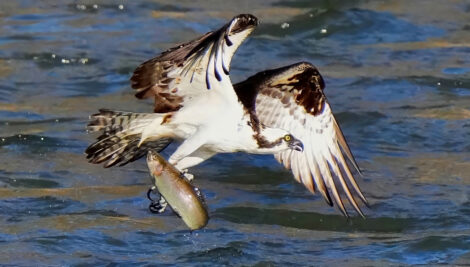Reflections in Nature: Birds, mammals, amphibians differ with raising their young
Recently, Mary Alice and I attended a family reunion at Rehoboth Beach in Delaware. Our son Mark and daughter-in-law, Amy, hosted the reunion. All four grandchildren and their spouses and five great-grandchildren attended.
We met a 4-month-old grandson from Washington State for the first time.
I do not like to drive in heavy traffic around the bigger cities, so our son met us halfway and drove the rest of the way to the beach
Since Colonial times newly married couples were encouraged to immediately move into homes of their own. The bridegroom’s family had to promise to help the couple find new accommodation as a condition of marriage. About the only time two generations lived together in the Colonial era was when the elderly became too old to care for themselves.
As our country was expanding young families headed west, saying farewells to families that perhaps they would never see again. The only way to keep in touch would be by writing letters.
Birds, mammals and amphibians — just like humans — have different ways of raising their young and varying lengths of time that the family unit stays together.
Wildlife family units also have a family reunion of sort. Take for instance the whitetail deer. When a doe is ready to have fawns, the previous year’s fawns either leave or are chased away. Throughout the summer months, the old doe stays with her new fawns, and then, with fall approaching, the older offspring reunite with the doe and her fawns.
Perhaps another doe, with offspring, will join them to form a herd. However, when winter sets in and food becomes scarce, it’s not uncommon for the female to chase her offspring away from food so that she is able to eat.
Another example of a family is that of a red fox. In the spring of the year, the male and female fox get together to raise a family. If both the male and female survived the winter, it is a good bet there will be a reunion between the male and female, and they will raise another family.
The male and the female select one of their den sites as a nursery and begin storing food down in the den. At the time the female is ready to give birth to her pups, she chases the male away and then enters the nursery den. It is very early in the year when the pups are born blind and hairless and they would surely freeze to death in minutes if abandoned by the female.
The vixen stays with the young, keeping the young warm and consuming the food that had been stashed away in the den. During this time, the male continues to drop extra food at the entrance to the den. When the cache of food stored inside the den is depleted, the vixen goes to the entrance of the den to get the food left there by the male fox. When the pups are a little older the male will be invited into the den for the first time.
Both parents put a lot of effort into raising their family. The fox family unit breaks up as fall approaches, with the male and female going their separate ways. There does not appear to be any more family contact.
The coyote parents stay with their pups throughout the year. During the following spring, only the alpha male and female mate again. The offspring of the previous year help to raise the pups from this mating. There will be many reports called in to the game commission about packs of coyotes being seen and heard near homes, what is being seen and heard are the family units.
Later, the older offspring disperse and start family units of their own.
Unlike the coyote, the wolf does run in packs, and this is another type of family unit. Other animals such as lions, elephants and caribou, for instance, stay together and form herds.
The female black bear’s cubs stay with their mother for almost two years. During this time, the female protects the cubs from all dangers, including the male bear. The sow only gives birth every other year, and when ready to breed again, the young either leave or are chased away and the family has no more contact.
The cottontail rabbit family does not stay together for very long. Some of the young leave at the ripe old age of 18 days. The female will begin another nest to have another brood. Although the young will stay in the same area as the female, there is no more contact.
Most female turtles simply dig holes in the ground, lay their eggs, and then cover the holes, leaving the warmth of the sun to do the hatching. From the very start, these young turtles receive no care.
Beaver parents and their young stay together for two years. At the time the third set of young are about to be born, the first set will leave the colony.
Most mammals use smell to recognize their young, whereas birds tend to use sound. Other factors can also play a part, including location and timing.
When animals leave their parents to establish their own lives, they do not appear to recognize each other. Most birds do not recognize their family members after their first year, except for social birds like cranes, crows, and jays. Canada Geese also remember their parents and may even rejoin them. It depends on the species.
Birds that live in social flocks, particularly the blue jays and American crows, recognize their paternal side of the family.
It seems that we humans and wildlife have much in common, breaking away from our families. Although we can still maintain contact with our families by letters, phone, and emails, nothing is better than personal contact and a family reunion. The family reunion allows humans to be able to get hugs and kisses or meet a new family member for the first time.
Bill Bower is a retired Pennsylvania Game Commission Wildlife Officer. Read his blog and listen to his podcasts on the outdoors at www.onemaningreen.com.


